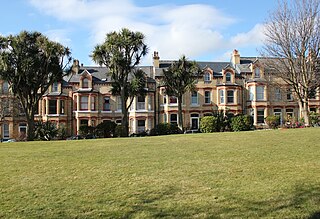
Peel is a seaside town and small fishing port in the Isle of Man, in the historic parish of German but administered separately. Peel is the third largest town in the island after Douglas and Ramsey but the fourth largest settlement, as Onchan has the second largest population but is classified as a village. Until 2016 Peel was also a House of Keys constituency, electing one Member of the House of Keys (MHK), who, from September 2015, was Ray Harmer. Peel has a ruined castle on St Patrick's Isle, and a cathedral, seat of the Diocese of Sodor and Man.

Frongoch internment camp at Frongoch in Merionethshire, Wales was a makeshift place of imprisonment during the First World War and the 1916 Easter Rising.

The Isle of Man has a rich transport heritage and boasts the largest narrow-gauge railway network in the British Isles with several historic railways and tramways still in operation. These operate largely to what is known as "Manx Standard Gauge" and together they comprise about 65 miles (105 km) of Victorian railways and tramways. The Isle of Man Railway Museum in Port Erin allows people to find out more about the history of the Manx railways, and was until 1998 accompanied by a similar museum in Ramsey, which was dedicated to the history of the electric line, but this was closed and converted into a youth club. The steam railway to the south of the island, electric to the north and mountain line to the summit of Snaefell, the island's only mountain, are all government-owned, and operated under the title Isle of Man Railways, as a division of the island's Department of Infrastructure. The lines at Groudle Glen and Curraghs Wildlife Park are both privately owned but open to the public.

Fort Missoula Internment Camp was an internment camp operated by the United States Department of Justice during World War II. Japanese Americans and Italian Americans were imprisoned here during this war.
One of the characteristics of the Isle of Man Railway are the numerous level crossings and farm crossings along the various routes; many smaller crossing places are marked only by gates the criss-cross farm land and provide access to individual private roads which connect the farms to the main roads. Being largely rural in nature the railway has many of these scattered along the existing South Line, and there were, as one might expect, many more on the closed sections of the railway. These can be summarised as follows, along with other points of interest along the line not covered in the Isle of Man Railway stations section:-

St Ninian's Crossroads is situated between the TT Grandstand and the 1st Milestone road-side marker on the Snaefell Mountain Course on the primary A2 Douglas to Ramsey road in the town of Douglas in the Isle of Man.
Knockaloe railway station served Knockaloe Internment Camp in the Isle of Man between 1915 and 1920.

Ramsey Hairpin is a point on the Snaefell Mountain Course used for the Isle of Man TT races on the Snaefell Mountain Road, designated as A18, in the parish of Maughold in the Isle of Man.

Barbed Wire is a 1927 American silent romance film set in World War I. It stars Pola Negri as a French farmgirl and Clive Brook as the German prisoner of war she falls in love with. The film was based on the 1923 novel The Woman of Knockaloe by Hall Caine. Unlike the original novel, which is set at the Knockaloe internment camp in the Isle of Man, the film takes place in Normandy, France. Some plot alterations were made in the adaptation, including most importantly the insertion of a happy ending.

This is a survey of the postage stamps and postal history of the Isle of Man.

Whitegates, a left-curve, is situated adjacent to the 24th mile road-side marker measured from the start/finish line on the Snaefell Mountain Course used for the Isle of Man TT and Manx Grand Prix motorcycle races. The area also has the historic 15th milestone on the primary A18 Mountain Road, showing the distance from Douglas, Isle of Man to the town of Ramsey.

George Kenner was a German artist. He made 110 paintings and drawings during the First World War while interned as a German civilian internee in Great Britain and the Isle of Man.
Sir William Patrick Byrne was a senior member of the British Civil Service.
The Metropole Internment Camp was a World War II internment camp in Douglas, Isle of Man. Officially known as “S” Camp, it was predominantly for Italians and was in existence from July 1940 until November 1944.

Hutchinson Internment Camp was a World War II internment camp in Douglas, Isle of Man, particularly noted as "the artists' camp" due to the thriving artistic and intellectual life of its internees.

Stobs Camp is a military and internment camp located just outside Hawick in the Scottish Borders. It is an internationally important site due to its level of preservation, being the best preserved World War 1 camp in Britain.
Cyril Clague was the author of the popular Manx dialect poem, The Peel Manx Tay Party.

The history of the Jews in the Isle of Man goes back to at least the early 19th century.
Selsior was a British silent film production company, which from 1913 to 1917 made films of dance performances for synchronisation with a live orchestra.













